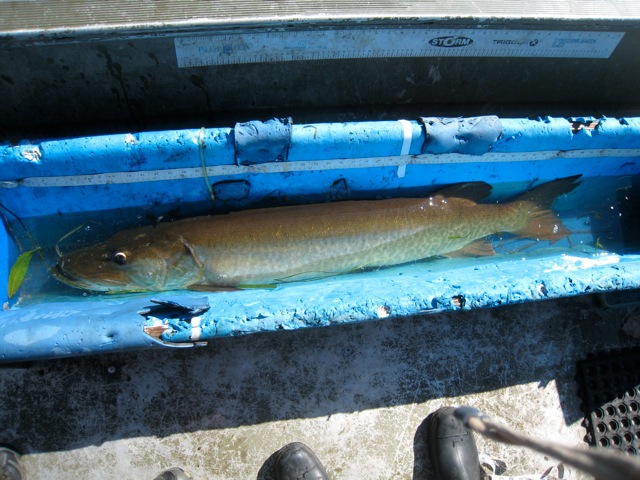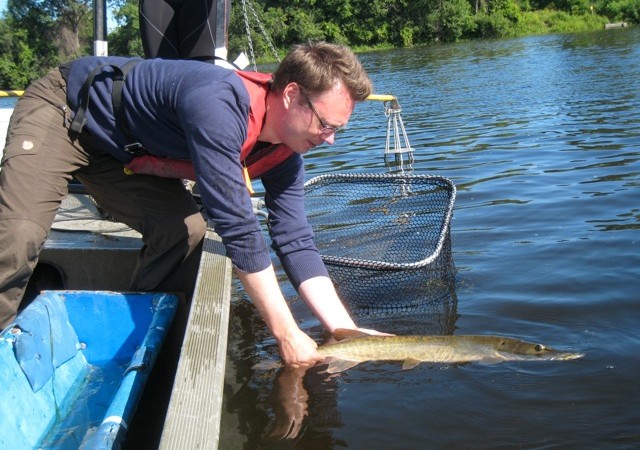Funded By
Richcraft and Minto contractors
Research Team
Dr. Steven Cooke, Carleton University
Dr. Jon Midwood, Carleton University
Karsten Pankhurt, Carleton University
Rideau Valley Conservation Authority
Ottawa Chapter, Muskies Canada Inc.
Richcraft
Minto
Research Summary
Background
The Brewer Park Pond restoration project has been in the works since the early 1990s, but it wasn’t until recent funding became available that the plan was able to gain some serious momentum. As habitat compensation for a development project in Orleans, the project has now been given the green light thanks to funding from Richcraft and Minto.
Brewer Park Pond was once a shallow wetland area that was part of the Rideau River. In the early 1960’s the wetland was filled in and the pond, now completely isolated from the river, was created. The pond initially served as a local swimming hole but issues with algae and concerns about water quality quickly emerged and the pond was closed to swimmers. Today, a half century later, the pond serves as a home to many aquatic organisms but unfortunately, low oxygen levels and fish kills make the pond uninhabitable for most fish species. For the habitat compensation project, 6720 m2 of fish habitat will be lost in Orleans and an equal or greater amount of fish habitat needs to replace it. At 13961 m2, reconnection of Brewer Park Pond to the Rideau River has the potential to create new fish habitat that is twice as large as the previous habitat in Orleans.
Goals
The goal of the Brewer Pond restoration project is to create a backwater wetland that aquatic species from the Rideau River can access. In addition to providing habitat to a range of wildlife species, this reconnection will help to prevent further fish kills in the Pond. A component of the project is focused on creating suitable spawning and nursery habitat for Muskellunge (Esox masquinongy) and Northern Pike (Esox lucius), the two apex predators in the Rideau River. Availability of spawning and nursery habitat is known to be a limiting factor to Muskie and Pike populations. Due to channelization and infilling of backwater areas along the shores of the Rideau River, there are very few suitable spawning habitats for these two species. This new habitat could potentially provide suitable spawning conditions for Muskie and Pike, which could have a significant impact on the future regional population size of these two species.
The proposed plan will involve the reconnection of the north end of Brewer Park Pond to the Rideau River through a 24.9 m culvert. This proposal is actually the 4th iteration of the reconnection plan. Plans to reconnect the Pond to the River first arose in the 1980s. However, the previous iterations each fell through for a variety of reasons, most notably legal issues and a lack of funding. As part of the current iteration it was originally planned to reconnect the Pond to the River through a dredged channel. However, safety concerns arose which led to the decision to reconnect the pond to the river using a culvert. Along with Richcraft and Minto, the Rideau Valley Conservation Authority (RVCA) and Ottawa Chapter of Muskies Canada Inc. are active partners in the current project. RVCA are heavily involved in the design of the new Pond, coordinating the restoration work and the instillation of structure and vegetation in the Pond. The Ottawa Chapter of Muskies Canada Inc. has provided insight into the design of the restorated pond and have also helped our group secure funding for a monitoring project and catch and track Pike and Muskies in the River.

Muskie caught by electrofishing the Rideau River, ready to be outfitted with a radio tag
Monitoring
Summer 2013
The concern going forward is whether or not the Muskie and Pike will actually use the culvert to move into and out of the pond. That’s where we come in. At Carleton University we have been fortunate enough to be given the role of monitoring the success of the project from the perspective of the Muskie and Pike. Over the summer of 2013, 20 Muskie and 20 Pike were caught between Hogs Back Falls and the 417 rapids in the Rideau River and radio tagged. Using radio telemetry, preliminary monitoring of the Muskie and Pike is ongoing. These “before” data will be used to analyze the ranges of Muskie and Pike, their ability to traverse rapids and their use of core habitat within the River near Brewer Park Pond. So far, we have found that Muskie and Pike have summer home ranges averaging between 1226 m and 1222 m, respectively (measured as length of the River). In addition, 27% of analyzed Muskie and 39% of analyzed Pike have ranges overlapping rapids, suggesting that they can easily move through rapids. Most importantly however, we found that 67% of the analyzed fish have core habitats within the areas near Brewer Park Pond. So you may be wondering what this means? Basically, this number tells us that there is a significant proportion of the population that could benefit from the reconnection of the Pond.
Winter 2014
Throughout the winter we have been doing weekly tracking of the Muskie and Pike between Hogs Back Falls and the 417 rapids. Tagging and tracking of esocids focused on this stretch of the River due to our interest in fish movements into Brewer Park Pond. When possible, areas downstream of the 417 and upstream from Carleton University have been tracked to see if tagged fish are moving beyond our area of focus. Currently we are able to track 32 of the 40 fish on a regular basis – the other 8 may have left the system downstream of the 417 rapids.
During the weekly tracking the most exciting part of the day was finding new fish. After the first day of tracking in December it was obvious that it wasn’t going to be a picnic detecting the fish through the ice. It was also very cold, which led to the weekly forecast becoming an important part of planning for tracking days. We were no longer able to track whenever it was convenient for us; from then on tracking days were based on Mother Nature’s plans. That being said, some days we had to brave -20 0C weather. and the bio-tracker decided it was too cold to function at times; patience sometimes seemed to fade in the cold. However, we pushed through it and every week more fish were found and we became much more efficient with our tracking.
Karsten Pankhurst radio tracking Pike and Muskie along the Rideau River.
Word is spreading about this exciting project! Please click here to read an interview with Dr. Steven Cooke in the Ottawa Citizen from June 2014.
What we Have Found
Based on the over-winter tracking data there are a few trends that can be discussed. First, the Muskellunge and Northern Pike did not move very much throughout the winter, and with the exception of a few fish they generally exhibited a small core range. The highest concentration of Muskellunge occurred between Brighton Beach and Windsor Park, with 9 Muskellunge tracked there regularly. The highest concentration of Pike occurred between Carleton University and Bronson Avenue, with 7 Pike tracked there regularly. In these two sections there was evidence of segregation of the two species, while in the river section between Brewer Pond and Bank Street there were coexisting Muskie and Pike. The stretch of river between Smythe Road and Highway 417 had few fish but there was evidence of segregation here , with alternating sections of Muskie and Pike. Finally, the water below each bridge was home to both species (Pike especially) at different times; most notably Bronson Avenue bridge was home to 5 Pike and 1 Muskie at times.
What’s next?
Now that spring is finally here the ice is beginning to break up. As of the last tracking date (April 5th) the Muskellunge and Northern Pike have yet to move from their winter positions. However, as of April 7th we will begin tracking daily and with the ice beginning to clear it won’t be long before the Northern Pike begin to spawn. Typically, Northern Pike begin spawning as soon as the ice melts. This year the ice melt has been relatively slow compared to recent years. Once the Pike begin spawning the Muskie are expected to spawn 2-5 weeks later. We will be tracking daily during spawning season and tracking will continue until the spawning of both species is complete.
Right now, the construction of the culvert is scheduled for the fall of 2014 and once it is completed we can begin studying the effectiveness of the new habitat. To do this, we will catch and tag more Muskie and Pike and move them into the pond to monitor whether they are able to pass through the culvert. In the meantime, we will continue weekly tracking along the Rideau River and hopefully, if everything goes to plan, we will have new spawning grounds for Muskie and Pike by 2015.
If you are interested in following the progress of this project follow @Musky_Pikey on twitter for weekly tracking results and fun facts.





